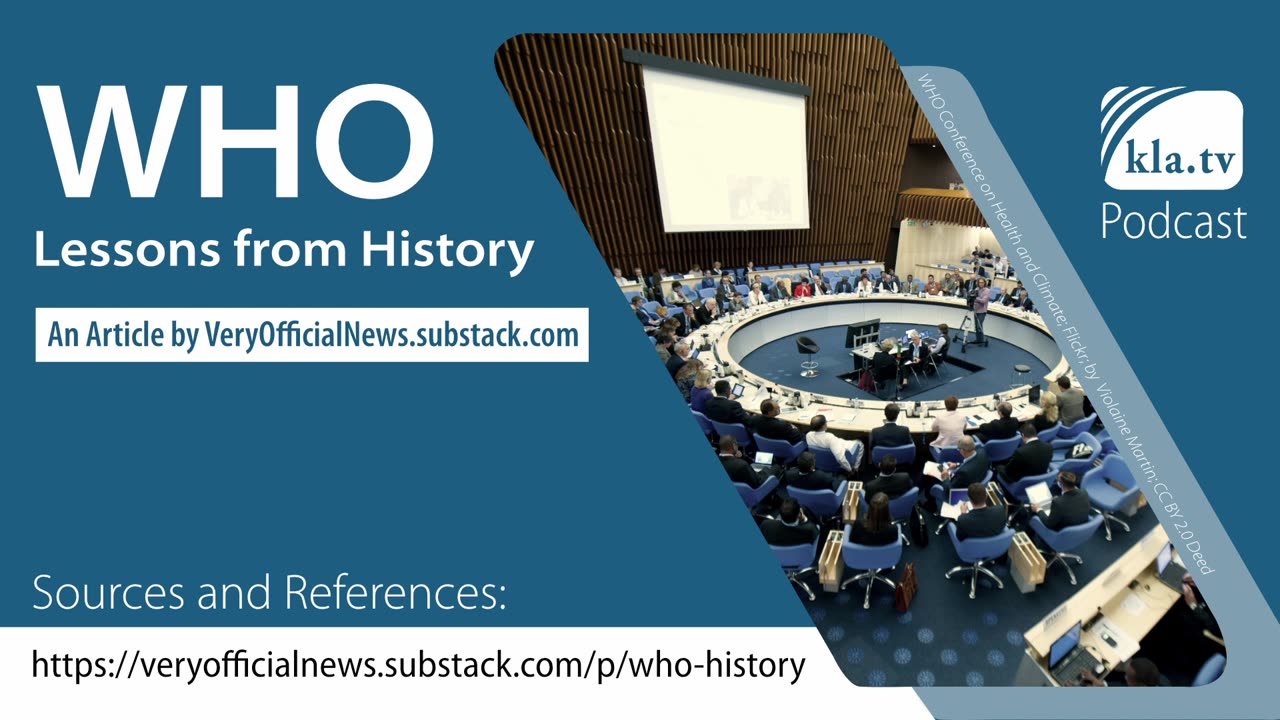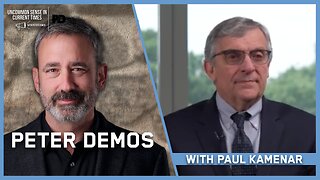Premium Only Content

WHO: Lessons from History
By the end of the reign of WHO Director-General Hiroshi Nakajima, he had been criticized for, quote, “autocratic style and poor management, his inability to communicate effectively, and, worst of all, cronyism and corruption” (Brown et al., 2006) and voluntary or “extrabudgetary” funds had already outpaced “assessed contributions” for the organization.
Assessed contributions are funds submitted on the basis of a country’s wealth, its GNP and population, and are funds which the WHO assembly holds authority over. By contrast, voluntary or “extrabudgetary” contributions must be used as directed by the contributors, eff ectively selling out the WHO’s priorities to the highest bidder.
I.e. quote, “Wealthy donor nations and multilateral agencies like the World Bank could largely call the shots on the use of the extrabudgetary funds they contributed” (Brown et al., 2006), causing “a great deal of dependence on the satisfaction of particular donors.” (Walt, 1993)
Nakajima was replaced by Gro Harlem Brundtland. Brundtland had been well-placed as chairperson of the World Commission on Environment and Development at the time of the 1992 UN Conference on the Environment and Development (“Earth Summit”) in Rio de Janeiro, which saw the adoption of the UN’s Agenda 21, later updated and broadened to Agenda 2030 and its Sustainable Development Goals, as well as the United Nations Framework Convention on Climate Change or UNFCCC, later famously extended with the Kyoto Protocol and Paris Agreement. The conference is credited as kicking off the trend of overt coziness between the UN and big business
According to the Third World Network, “In 1998, Brundtland, newly elected as Director-General of WHO, told member states that one of the hallmarks of her term would also be increased cooperation with the private sector under the name of public-private partnerships.”
As detailed in “The World Health Organization and the Transition From “International” to “Global” Public Health” by Brown et al.,
[Brundtland] began to strengthen WHO’s financial position, largely by organizing “global partnerships” and “global funds” to bring together “stakeholders”—private donors, governments, and bilateral and multilateral agencies—to concentrate on specific targets… These were semiautonomous programs bringing in substantial outside funding, often in the form of “public–private partnerships.”
In 1999, Brundtland’s WHO drew up a document titled “Influenza Pandemic Plan: The Role of WHO and Guidelines for National and Regional Planning.”
The British Medical Journal smelled a rat. revealing that, “In the small print of that document it states: “R Snacken, J Wood, L R Haaheim, A P Kendal, G J Ligthart, and D Lavanchy prepared this document for the World Health Organization (WHO), in collaboration with the European Scientific Working Group on Influenza (ESWI).”
What this document does not disclose is that ESWI is funded entirely by Roche and other influenza drug manufacturers. Nor does it disclose that René Snacken and Daniel Lavanchy were participating in Roche sponsored events the previous year, according to marketing material seen by the BMJ/The Bureau.”
The BMJ went on to identify several additional members of the European Scientific Working Group on Influenza in Roche’s marketing materials.
That same year, the FDA would be offered new antivirals for pandemic preparedness called neuraminidase inhibitors by both Roche and the company that is now GlaxoSmithKline. When Dr. Elashoff, the statistician assigned to review both drugs, determined first that Glaxo’s drug lacked efficacy, and the FDA panel rejected the drug, the FDA overruled its panel and approved it. It then reassigned Roche’s drug to someone else, approving it shortly thereafter. (Cohen & Carter, 2010)
In 2002, the WHO held a meeting of influenza experts for the use of vaccines and antivirals during an influenza pandemic. In 2004, the organization published a report from that meeting, “WHO Guidelines on the Use of Vaccines and Antivirals during Influenza Pandemics”, which had three annexes, all written by authors with relevant conflicts of interest that were not provided by the WHO. That the organization did not publicly disclose any of these conflicts of interest is particularly disturbing because governments around the world were advised based on the guidelines, which recommended stockpiling the drugs.
In short order, 10 billion dollars were spent on Roche’s Tamiflu, and roughly 2 billion on GSK’s Relenza.
The BMJ asked the WHO directly for the Declaration of Interest statements provided by participants, but was denied.
Dr. Arnold Monto, exposed to have been paid by both Roche and GSK, was the lone author on the annex on pandemic vaccination, and was cited as substantiating the efficacy of neuraminidase inhibitors in the annex on antivirals despite that, per the BMJ’s expose, findings of such ostensible efficacy were profoundly difficult to replicate elsewhere. In fact, in a later collaboration with the highly respected Cochrane Review, the BMJ would leave such claims handily discredited, much to the embarrassment of the WHO, which had already placed Tamiflu on its list of “essential medicines”. (Kelland, 2010)
Dr. Monto would later become fairly well-known to Americans tuning in to the FDA’s VRBPAC meetings in the COVID era, as a result of the fact that, in addition to being a voting panelist, he was the one who led them. From the perspective of the biopharmaceutical industry that underwrites three quarters of the FDA’s review budget (Chen, 2018), Monto did not disappoint.
For example, on June 28, 2022 when Dr. Ofer Levy asked Pfizer’s science VP whether her meager eight-mouse antibody data (Mole, 2022) had any correlates of protection, Monto was there to rush the answer, appearing completely undeterred by her admission that there were “no correlates of protection”. (U.S. Food and Drug Administration, 2022)
He then falsely proclaimed to the panel “we have to pick one” of the shot formulations, implying that no paucity of data would lead him to rejection (U.S. Food and Drug Administration, 2022). The apparent preordination was so shameful that one of the FDA’s most avidly pro-vaccine panelists ceded in a subsequent interview that he felt “the fix was in.” (ZDoggMD, 2022)
Returning to the chronicle, 2005 was a landmark year in the pandemic preparedness sequence. There was the Avian flu scare, for which Dr. David Nabarro, one of the most senior and prominent public health experts at the World Health Organization, told the BBC that the "range of deaths could be anything between five and 150 million.” (Sturcke, 2005)
Of course, nothing remotely close to those figures occurred, nor was it ever reasonably inferable. Ontario's former chief medical officer went so far as to decry the rhetoric as “fraud”. (Andresen, 2006)
This did not stop the Bush administration from vying to spend 7 billion dollars (Tucker, 2020) on the panic, nor Donald Rumsfeld from making a “killing” (Lean & Owen, 2006) from Tamiflu profits allotted to Gilead sciences, which had developed the drug for Roche. Rumsfeld had been on the board of Gilead before joining the Bush administration, a company that became better known in the COVID era for developing remdesivir, a drug which was recommended for COVID treatment in the United States by a panel with 9 members receiving financial support from the company (NIH, 2023) following a last-minute change in the primary endpoint of its NIAID trial, detailed in the Washington Post.
“I think that they thought they weren’t going to win, and they wanted to change it to something they could win on,'' said Steven Nissen, a Cleveland Clinic cardiologist and expert clinical investigator who has led numerous drug trials.
…Gilead did not respond to a question about whether it had input on the decision to change the endpoint.
The obscenely lucrative drug (Maybarduk, 2020), notable for its tendency to precipitate kidney failure (Gérard et al., 2021), took on preeminent status in federal recommendations (NIH, 2023), becoming widely used in hospitals across the US (McCarver, 2021), which, perhaps not entirely coincidentally, had the highest death rate in the developed world (including in 2020, before things like varying vaccination rates could have been fingered for the discrepancy). (Cortez, 2020)
Later studies suggested the drug actually increased the length of hospital stays rather than reducing them. (McCarver, 2021)
Most crucially, 2005 was the year the World Health Organization came out with its updated version of the International Health Regulations.
The WHO had drafted the original International Health Regulations (IHR) in 1969, which themselves represented a “revised and consolidated version of the previous International Sanitary Regulations.” (PAHO)
The 2005 revision was designed to comparatively increase the legislative and constitutional power of the WHO. Among other things, the 2005 IHR empowered the WHO Director-General to declare Public Health Emergencies of International concern, or PHEICs.
The 2005 International Health Regulations officially went into force in the summer 2007, in near-simultaneity with the establishment of advanced supply contracts for pandemic-specific vaccines with drugmakers, referred to in British parliament as “sleeping contracts”. (Hansard, 2007)
The WHO was almost ready to declare its first Public Health Emergency of International concern.
from ---
Sources/Links:
https://veryofficialnews.substack.com/p/who-history?utm_source=profile&utm_medium=reader2
https://www.ncbi.nlm.nih.gov/pmc/articles/PMC1470434/
https://pubmed.ncbi.nlm.nih.gov/10126754/
https://en.wikipedia.org/wiki/United_Nations_Framework_Convention_on_Climate_Change
https://www.twn.my/title2/resurgence/2015/298-299/cover02.htm
https://www.corpwatch.org/article/greenwash-10#rio
https://www.bmj.com/content/bmj/340/7759/Feature.full.pdf
https://www.youtube.com/watch?v=BFdzNUus_CE&t=11104s
https://www.youtube.com/watch?v=BFdzNUus_CE&t=14014s
https://www.youtube.com/watch?v=PLo2Wwa3NNA
https://www.theguardian.com/world/2005/sep/30/birdflu.jamessturcke
https://www.ncbi.nlm.nih.gov/pmc/articles/PMC1534081/
https://www.aier.org/article/a-retrospective-on-the-avian-flu-scare-of-2005/
https://www.covid19treatmentguidelines.nih.gov/about-the-guidelines/panel-financial-disclosure/
https://www.citizen.org/news/gileads-remdesivir-price-is-offensive/
https://pubmed.ncbi.nlm.nih.gov/33340409/
https://www.paho.org/en/documents/international-health-regulations-1969
https://hansard.parliament.uk/commons/2007-10-09/debates/0710106000132/VaccinesSleepingContracts
-
 18:38
18:38
VSiNLive
1 day agoProfessional Gambler Steve Fezzik LOVES this UNDERVALUED Point Spread!
94.9K17 -
 LIVE
LIVE
Right Side Broadcasting Network
10 days agoLIVE REPLAY: President Donald J. Trump Keynotes TPUSA’s AmFest 2024 Conference - 12/22/24
5,530 watching -
 4:31
4:31
CoachTY
21 hours ago $21.53 earnedCOINBASE AND DESCI !!!!
113K9 -
 10:02
10:02
MichaelBisping
20 hours agoBISPING: "Was FURY ROBBED?!" | Oleksandr Usyk vs Tyson Fury 2 INSTANT REACTION
57K13 -
 8:08
8:08
Guns & Gadgets 2nd Amendment News
2 days ago16 States Join Forces To Sue Firearm Manufacturers Out of Business - 1st Target = GLOCK
91K86 -
 10:17
10:17
Dermatologist Dr. Dustin Portela
2 days ago $17.45 earnedOlay Cleansing Melts: Dermatologist's Honest Review
132K10 -
 1:02:20
1:02:20
Trumpet Daily
2 days ago $41.37 earnedObama’s Fake World Comes Crashing Down - Trumpet Daily | Dec. 20, 2024
89.9K58 -
 6:29
6:29
BIG NEM
1 day agoCultivating God Mode: Ancient Taoist NoFap Practices
66.6K17 -
 30:53
30:53
Uncommon Sense In Current Times
2 days ago $10.87 earned"Pardon or Peril? How Biden’s Clemency Actions Could Backfire"
80.7K5 -
 40:01
40:01
CarlCrusher
1 day agoSkinwalker Encounters in the Haunted Canyons of Magic Mesa - ep 4
74.7K9